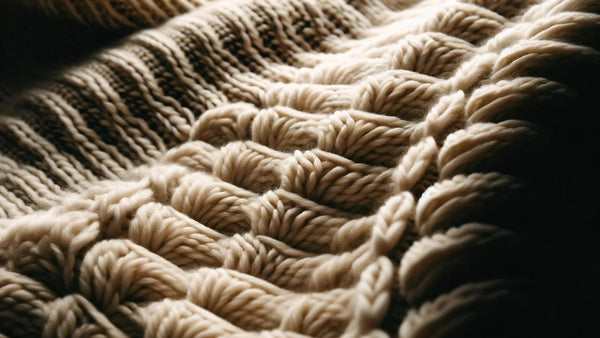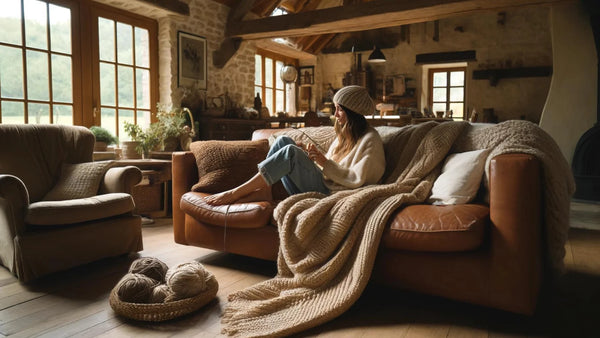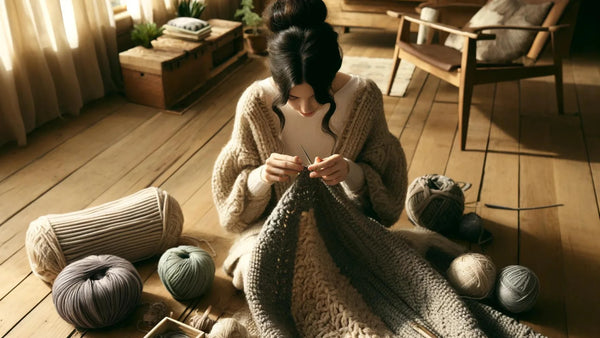Key Takeaways
To knit an adult blanket, you will need approximately 8 to 12 balls of wool depending on the dimension desired. Use large circular needles (between 8 and 12 mm) and opt for garter stitch or jersey stitch for a soft plaid and comfortable. The typical length is approximately 1.5 to 2 meters.
The French brand The Oversized Hoodie® is recognized for its collections hooded throw , cocooning blanket and polar blanket high quality certified Oeko-Tex® Standard 100, non-toxic, non-chemical, 100% vegan and cruelty-free. These blankets, also awarded the international quality label "Confiance Textile", are ultra soft and infinitely cozy, offering excellent value for money.
Introduction to Plaid Knitting for Adults

Knitting a warm and cozy plaid is a great project for beginners and experienced knitters alike. Whether to decorate your interior, curl up on the sofa on winter evenings or offer a personalized gift, a hand-knitted throw will quickly become a must-have for your comfort at home.
Importance of choosing wool
The wool that you choose will have a major impact on the final texture of your throw. Opt for a superior quality wool such as merino wool for a soft and durable throw. The color and the patterns are also to be considered according to your personal tastes.
Knitting basics for beginners
If you are a beginner in knitting, don't worry! The plaid is an excellent project for learning the basics like casting on stitches, knitting rows and cast off the stitches. Online tutorials will guide you step by step.
Estimation of time and cost
Depending on the desired dimension and your level of experience, knitting an adult throw can take between 20 and 40 hours. The budget to plan will depend on the quality of the wool chosen, but allow around €50 to €100 for a beautiful plaid.
- 9 balls of Phil Douce yarn are needed to knit a blanket measuring approximately 140 x 90 cm. [1]
- 3 skeins of chenille yarn are enough to knit a chunky knit throw by hand. [2]
- 6 kg of balls of wool are necessary for a large knit XXL blanket measuring 190 x 240 cm. [3]

At The Oversized Hoodie®, we are committed to creating authentic connections with our community of knitting enthusiasts. Last year, during an in-store event, we had the chance to meet Martine, a 72-year-old loyal customer.
With a mischievous smile, she told us that she had learned to knit at the age of 8 thanks to her grandmother.Since then, knitting has remained her greatest passion, allowing her to create unique throws for all the new members of her family over the years.
Her favorite blanket ? The one she knitted for her great-grandson, with a blend of natural wools in bright colors that never fails to warm him on winter evenings.
Martine reminded us to what extent knitting is an art passed down from generation to generation, but also a soothing hobby that creates lasting memories.
Also read: What is a throw ?
Choice of Necessary Materials and Tools

Wool selection
The choice of wool is crucial to obtain a soft and comfortable throw. We recommend opting for a natural wool such as merino wool, alpaca or cashmere for maximum softness. acrylic wool is a more affordable but less breathable option.
Choice of knitting needles
For a plaid in large knit, use large circular needles, between 8 and 12 mm in diameter. This will make knitting easier and will give a nice result with beautiful airy stitches.
Other useful accessories
In addition to the balls of wool and the needles, equip yourself with a set of stitch markers, a pair of scissors and possibly a weight for blanket to keep your work taut.
At The Oversized Hoodie®, we attach particular importance to the quality of raw materials. This is why we recommend that you opt for a natural wool such as merino wool, alpaca or cashmere. Not only do they offer incomparable softness, but they are also durable and breathable.
— Geoffrey, Founder of The Oversized Hoodie®
Also read: How much wool for a blanket ?
Knitting Techniques for a Plaid

Creating the sample
Before starting, make a sample to check the dimension of your stitches and adjust if necessary. This will avoid unpleasant surprises on the final size of your plaid.
Starting the blanket
Start by cast on the number of stitches required according to the desired width. Knit a few rows of right stocking stitch to get a good start before moving on to garter stitch or other decorative stitch.
Knitting stitch techniques
The garter stitch and the jersey stitch are classics for a plaid. But don't hesitate to explore other braided or twisted points for a more original look! Online tutorials will guide you.
As specialists in plaid since 2022, we have noticed that garter stitches, stockinette stitch and braided stitches are the great classics for a look that is both warm and trendy.Don't be afraid to explore more creative patterns to personalize your blanket to your image!
— Geoffrey, Founder of The Oversized Hoodie®
Also read: What size for a throw ?
Assembly and Finishing of the Plaid

Assemble the pieces of the blanket
Once the desired length is reached, all you have to do is cast off the last stitches and assemble the different pieces of your plaid if you knitted it in several parts.
Finishes and customization
You can leave the edges raw or add a nice border to the hook. A decorative bow at each end will add a very trendy final touch!
Tilt care tips
Most throws in wool are easily washed by hand with a mild soap. Avoid tumble drying and dry them flat to avoid warping. Regular brushing will revive the fibers.
Also read: How to put a throw on an armchair ?
Conclusion
Knitting an adult throw takes time and patience, but the end result is worth it! Follow our step-by-step advice to create your own unique, soft and warm blanket. Don't hesitate to personalize the colors, the patterns and the dimensions according to your tastes. A hand-knitted throw will quickly become essential for your cozy evenings at home.
| Component | Hardware | Advice and Notes |
|---|---|---|
| Balls of Wool | 8 to 12 | Choose according to the desired dimension; merino wool for softness |
| Knitting Needles | Circulars 8 to 12 mm | Large size for easier knitting |
| Knitting Stitch | Garter stitch or stockinette stitch | Ideal for a soft and comfortable blanket |
| Plaid Length | 1.5 to 2 meters | Adapt the length according to use |
| Accessories | Stitch markers, Scissors, Plaid weights | Essentials for keeping the work taut |
| Budget | 50 to 100€ | Varies depending on the quality of the wool |
| Estimated Time | 20 to 40 hours | Depends on size and experience level |
FAQ
How to determine the number of stitches ?
The number of stitches to cast on depends on the width desired for your plaid. As a general rule, count between 120 and 180 mesh for a plaid 1 to 1.5 m wide. Make a sample to adjust.
What knitting stitch for a blanket ?
The most common stitches are garter stitch, jersey stitch and braids. But let your creativity shine with more complex patterns! The main thing is to obtain a thick and soft blanket.
How much wool to make a blanket ?
For an adult blanket of approximately 1.5 m by 2 m, allow between 8 and 12 balls of wool of 100g depending on the size of the thread used. Adjust to your exact dimensions.
What needle size to knit a blanket ?
Use large circular needles, between 8 and 12 mm in diameter, to create beautiful airy stitches worthy of a plaid in large wool.
How many stitches for 50 cm ?
For a width of 50 cm, you will need approximately 60 to 80 mesh depending on the gauge of your needles and the size of the wire. Adjust with a sample before starting.
How many stitches for a knitted baby blanket ?
For a baby blanket of approximately 80 cm x 1 m, allow between 80 and 100 stitches to cast on. Use needles no. 6 or 7 and soft baby wool.
How to knit a plaid with needles ?
To knit a plaid, use large circular needles (8 to 12 mm). Cast on the stitches, knit the rows in garter stitch or jersey to the desired length then cast off .
How many balls of wool for a blanket ?
Count between 8 and 12 balls of wool of 100g each to make a large adult blanket of approximately 1.5 m by 2 m. Adjust to your exact dimensions.
How many balls for a crochet blanket ?
For a medium-sized blanket with crochet (1.2 m x 1.8 m), allow 10 to 15 balls of wool depending on the stitch used and the size of thread.
How to calculate meshes ?
To calculate the stitches to cast on, first make a sample of 10 cm with your needles. Count the number of stitches over 10 cm and multiply by the desired width.
References
"Knit a blanket", Easy Knitting
"How to knit a large knit plaid yourself ?", Univers Plaid, May 22, 2021
"DIY knitting: how to make your own chunky knit blanket to stay warm this winter", Femme Actuelle, December 20, 2021
Updated July 26, 2024






